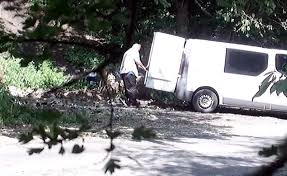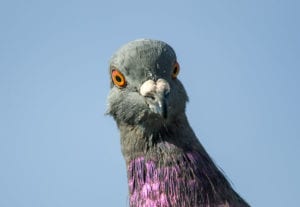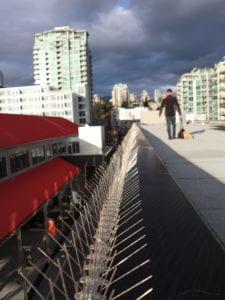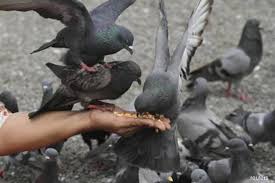
by Pigeon Patrol | Feb 26, 2020 | 4-S Gel Bird repellent, Animal Deterrent Products, Bird Deterrent Products, Bird Netting, Bird Spikes, Pigeon Control, Pigeon Droppings, Pigeon Patrol's Services, Pigeon Spikes, Pigeons in the News
Outbreak of Trichomoniasis in a wood pigeons wintering roost
An outbreak of wood pigeons (Columba palumbus) winter each year in southwestern Spain and Portugal, where they feed on acorns.
Although mortality in these wintering roosts is generally low, in winter and spring 2001 approximately 2,600 woodpigeons died from trichomoniasis.
Diagnosis of the disease was based on postmortem examination, culture and identification of the parasite, Trichomonas gallinae, by PCR. Other viral, bacterial or fungal pathogens were ruled out as cause for the die-off. The gathering of the woodpigeons at game bird feeders set up for red-legged partridges may have contributed to the outbreak.
Mortality ceased after treatment with dimetridazole via the game bird feeders. Supplementary feeding of game birds constitutes a risk factor for the appearance of disease outbreaks.
Close monitoring of infectious diseases in these populations is important, but treatment of free-living birds should be avoided in favour of other measures, as it poses risks.
Source
At Pigeon Patrol, we manufacture and offer a variety of bird deterrents, ranging from Ultra-flex Bird Spikes with UV protection, Bird Netting, 4-S Gel and the best Ultrasonic and audible sound devices on the market today.
Contact us at 1- 877– 4– NO-BIRD, (604) 585-9279 or visit our website at www.pigeonpatrol.ca
Bird Gone, Pigeon Gone, Seagull Gone, Pigeon issue, pigeon spikes, 1-877-4NO-BIRD, 4-S Gel, Bird Control, Pigeon Control, bird repellent, Bird Spikes, sonic bird repellent, stainless steel bird spikes, bird spikes Vancouver, Ultra Sonic Bird Control, Bird Netting, Plastic Bird Spikes, Canada bird spike deterrents, Pigeon Pests, B Gone Pigeon, Pigeon Patrol, pest controller, pest control operator, pest control technician, Pigeon Control Products, humane pigeon spikes, pigeon deterrents, pigeon traps, Pigeon repellents, Sound & Laser Deterrents, wildlife control, raccoon, skunk, squirrel deterrent, De-Fence Spikes, Dragons Den, Canada bird spikes, Canada pigeon, pigeon control, pigeon patrol, pigeon. Kill pigeons, crow, starling

by Pigeon Patrol | Feb 26, 2020 | 4-S Gel Bird repellent, Animal Deterrent Products, Bird Spike, Pigeon Control, Pigeon Droppings, Pigeons in the News, UltraSonic Bird Control
Zombie pigeon epidemic sparks fears of transmission to humans
An “epidemic” of pigeon deaths in Moscow has sparked speculation that birds were succumbing to a virus dangerous to human beings. People who came across sick birds paying no attention to cars or passersby described them as “zombie pigeons.”
On Wednesday the Federal Veterinary and Phytosanitary Inspection Service reported that the birds’ abnormal behavior was caused by the so-called “Newcastle disease,” which can spread to humans.
Moscow’s Veterinary Committee said the mass death of pigeons in the capital was due to salmonellа poisoning, an intestinal infection spread among animals and humans. Veterinary specialists detected lesions on the gastrointestinal tracts and livers of the dead birds caused by salmonella, not Newcastle disease, Interfax reported.
Autopsies of dead birds showed that they had all suffered from a common intestinal infection that is not dangerous to humans, said Moscow’s deputy mayor for social issues, Leonid Pechatnikov. Neither the bird flu, dangerous to humans, nor fowl plague or any other diseases threatening people have been found, he said.
Gennady Onishchenko, Russia’s chief sanitary inspector, said that while the word “pigeon epidemic” was often used in the press, he doubted it could described as one. However, he warned that parents should take care if their children could come into contact with sick birds.

“We are especially worried about children’s playgrounds… And if a dead bird is found on the balcony, it must be washed with disinfectant. Doing this, one must be wearing rubber gloves,” Onishchenko said.
Although the birds’ salmonella is not harmful to humans, direct contact with the sick birds should be avoided, veterinarians said.
“The disease poses no risk for humans, provided standard precautions of personal hygiene are observed and direct contact with sick birds is avoided. Activators of avian influenza and psittacosis (an infection that can be transmitted to humans) have not been identified,” the committee said.
Salmonella infections in humans usually resolve in 5-7 days, but a small number of persons with Salmonella develop pain in their joints, irritation of the eyes and painful urination. The so-called Reiter’s syndrome can last for months or years, and can lead to chronic arthritis.
Newcastle disease, which is transmissible to humans, can cause mild conjunctivitis and influenza-like symptoms.
Ornithologists say that the so-called “epidemic” occurs every year, and not only in Moscow. “Most often, it begins in August. This is due to the fact that the breeding season is over, young birds come out with reduced immunity, and they are more susceptible to all infectious diseases,” ornithologist Natalia Anisimova told Russia’s TV Dozhd (Rain).
source
At Pigeon Patrol, we manufacture and offer a variety of bird deterrents, ranging from Ultra-flex Bird Spikes with UV protection, Bird Netting, 4-S Gel and the best Ultrasonic and audible sound devices on the market today.
Contact us at 1- 877– 4– NO-BIRD, (604) 585-9279 or visit our website at www.pigeonpatrol.ca
Bird Gone, Pigeon Gone, Seagull Gone, Pigeon issue, pigeon spikes, 1-877-4NO-BIRD, 4-S Gel, Bird Control, Pigeon Control, bird repellent, Bird Spikes, sonic bird repellent, stainless steel bird spikes, bird spikes Vancouver, Ultra Sonic Bird Control, Bird Netting, Plastic Bird Spikes, Canada bird spike deterrents, Pigeon Pests, B Gone Pigeon, Pigeon Patrol, pest controller, pest control operator, pest control technician, Pigeon Control Products, humane pigeon spikes, pigeon deterrents, pigeon traps, Pigeon repellents, Sound & Laser Deterrents, wildlife control, raccoon, skunk, squirrel deterrent, De-Fence Spikes, Dragons Den, Canada bird spikes, Canada pigeon, pigeon control, pigeon patrol, pigeon. Kill pigeons, crow, starling

by Pigeon Patrol | Feb 16, 2020 | Animal Deterrent Products, Bird Spike, Pigeon Control, Pigeon Droppings, Pigeon Spikes, UltraSonic Bird Control
Controlling Pigeon Nuisance
The common pigeon (Columba livia) that thrives throughout Missouri and most other states was developed from the European rock dove and introduced into this country as a domesticated bird. When these birds escaped captivity, they formed feral populations. Today, the pigeon is a nuisance and probably the most serious bird pest associated with human habitations.
Pigeons are commonly found around farmyards, grain elevators, feed mills, parks, city buildings, bridges and other areas that provide roosting, loafing and nesting sites. They are also a common sight around home bird feeders.
Problems caused by pigeons
Nuisance pigeon droppings on park benches, cars and buildings are not only unsightly and smelly but also corrosive, particularly to buildings. Large amounts of droppings also can kill vegetation.
Around farms, grain elevators and feed mills, pigeons consume and contaminate large quantities of grain.
Pigeons have been implicated in the transmission of diseases such as pigeon ornithosis, encephalitis and salmonella food poisoning. However, the actual incidence of transmission of diseases from pigeons to people is difficult to assess. Disease outbreaks that are directly attributed to pigeon flocks are rare.
Pigeon manure, if allowed to accumulate for several years, can harbor the causal agent of histoplasmosis, a systemic fungus disease that affects the human respiratory tract. In severe cases, histoplasmosis can be fatal. The external parasites of pigeons include various species of mites, fleas, ticks and bugs.
In addition to being a threat to human health, pigeons can be a threat to human safety, particularly around airports, where pigeon flocks have collided with aircraft, causing human fatalities.
To find out more
At Pigeon Patrol, we manufacture and offer a variety of bird deterrents, ranging from Ultra-flex Bird Spikes with UV protection, Bird Netting, 4-S Gel and the best Ultrasonic and audible sound

devices on the market today.
Contact us at 1- 877– 4– NO-BIRD, (604) 585-9279 or visit our website at www.pigeonpatrol.ca
Bird Gone, Pigeon Gone, Seagull Gone, Pigeon issue, pigeon spikes, 1-877-4NO-BIRD, 4-S Gel, Bird Control, Pigeon Control, bird repellent, Bird Spikes, sonic bird repellent, stainless steel bird spikes, bird spikes Vancouver, Ultra Sonic Bird Control, Bird Netting, Plastic Bird Spikes, Canada bird spike deterrents, Pigeon Pests, B Gone Pigeon, Pigeon Patrol, pest controller, pest control operator, pest control technician, Pigeon Control Products, humane pigeon spikes, pigeon deterrents, pigeon traps, Pigeon repellents, Sound & Laser Deterrents, wildlife control, raccoon, skunk, squirrel deterrent, De-Fence Spikes, Dragons Den, Canada bird spikes, Canada pigeon, pigeon control, pigeon patrol, pigeon. Kill pigeons, crow, starling

by Pigeon Patrol | Feb 16, 2020 | Animal Deterrent Products, Bird Deterrent Products, Bird Netting, Bird Spike, Pigeon Control, Pigeon Droppings, Pigeon Patrol's Services, Pigeon Spikes
Pigeon allergy: A pigeon allergy is an adverse reaction by the body’s immune system to pigeons. The allergy is usually associated with the skin, feathers or excrement of the pigeon. The body’s immune system produces immunoglobulin E (IgE – an antibody) and histamine in response to contact with the allergen. The specific symptoms that can result can vary considerably amongst patients e.g. skin and respiratory symptoms
- Avoid contact with the allergen, antihistamines, bronchodilators for asthmatic symptoms
- Animal allergy is best treated by prevention of exposure to sensitising agents. Where this is not possible, treatment of allergy is dependant upon the type of allergic symptom, the body system affected, and the severity of the reaction
To find out more please visit here
At Pigeon Patrol, we manufacture and offer a variety of bird deterrents, ranging from Ultra-flex Bird Spikes with UV protection, Bird Netting, 4-S Gel and the best Ultrasonic and audible sound devices on the market today.
Contact us at 1- 877– 4– NO-BIRD, (604) 585-9279 or visit our website at www.pigeonpatrol.ca
Bird Gone, Pigeon Gone, Seagull Gone, Pigeon issue, pigeon spikes, 1-877-4NO-BIRD, 4-S Gel, Bird Control, Pigeon Control, bird repellent, Bird Spikes, sonic bird repellent, stainless steel bird spikes, bird spikes Vancouver, Ultra Sonic Bird Control, Bird Netting, Plastic Bird Spikes, Canada bird spike deterrents, Pigeon Pests, B Gone Pigeon, Pigeon Patrol, pest controller, pest control operator, pest control technician, Pigeon Control Products, humane pigeon spikes, pigeon deterrents, pigeon traps, Pigeon repellents, Sound & Laser Deterrents, wildlife control, raccoon, skunk, squirrel deterrent, De-Fence Spikes, Dragons Den, Canada bird spikes, Canada pigeon, pigeon control, pigeon patrol, pigeon. Kill pigeons, crow, starling

by Pigeon Patrol | Feb 16, 2020 | Bird Deterrent Products, Bird Netting, Bird Spike, Pigeon Control, Pigeon Patrol's Services, Pigeon Spikes, Pigeons in the News
The dossier spills over into two drawers of files full of hand-scribbled notes, maps marked with sharp black dots – and snapshots of a shadowy lady figure, scattering pigeon seed.
This is Laura Dodson’s nemesis.
There was a time when Dodson went after the crack dealers in her Hollywood neighborhood with such a vengeance that city officials honored her with a plaque. Now, she has declared war on another urban scourge. For three years, she has enlisted snitches, set up overnight stakeouts, appealed for help from city leaders and the police.
Her quarry? Pigeon lady Susie Kourinian, the furtive form in the photos.
Kourinian is no ordinary bird lover. She earns her seed money as a seamstress to the stars; she appeared in InStyle magazine tweaking Cate Blanchett’s hem and is said to keep actresses such as Megan Mullally in finery.
That glittery occupation gives Kourinian the wherewithal to make a lot of pigeons happy. Kourinian once told police she spends $65,000 a year on bird feed – enough to dump 500 pounds of birdseed every day, a lifeline for the more than 5,000 pigeons who now populate the two square miles of this neighborhood northwest of downtown Los Angeles.
Kourinian is reputedly so crafty that within moments, she can pop the trunk of her black sport utility vehicle, scatter 75 pounds of pigeon feed and disappear into the night.
She has been doing this for a decade, police say, but neither they nor Dodson’s small band of pigeon patrollers – dubbed “Citizen Pigeon” – have been able to stop her.
“When you realize how many hours and manpower it takes to catch the pigeon lady … ,” Dodson said. “She’s got the perfect crime because who else would have the resources to do this?”
Across the nation, a virtual war on pigeons has been waged in many ways: poisonings, electric wires, robotic falcons and even bird relocations to pigeon farms. In some places the mere mention of feeding bans has raised the ire of legions of pigeon fanciers who ridicule efforts to levy fines for tossing birds a handful of bread crumbs.
But pigeons will reproduce based on the amount of food available. In Hollywood, they have.
Stephanie Boyles, a wildlife biologist with the Humane Society who has developed pigeon control programs around the country, said she’s never seen anything like it. To get a sense of how bad the problem was, she once scattered some bread in a Hollywood parking lot.
Within moments, the bread was gone and thousands of eyes were upon her. An eerie cooing suggested they wanted more.
“I’ve traveled in Europe, I’ve been to New York City many, many times, Washington D.C. and Chicago … places that claim to have pigeon problems. They do, but compared to Hollywood, it’s not even a fair comparison,” Boyles said.
Critics maintain that pigeons do millions of dollars in damage a year nationwide. Their guano is caustic, and has been blamed for all sorts of problems, from poor water quality in Pismo Beach to the collapse of the Minneapolis bridge.
In Hollywood, critics say, the pigeons conflict with a beautification program aimed at reviving the famed neighborhood, for years blighted by dingy sex shops along the Hollywood Walk of Fame. When officials took down the marquee of Grauman’s Chinese Theatre to refurbish the building, pigeon guano had completely corroded the metal.
Legions of pigeons sit waiting for food on rooftops, under freeways and telephone lines, prompting business owners to put up canopies and umbrellas to protect customers.
“If I were to feed 5,000 cats a day, you know how many cats we’d see a year from now?” said Thaddeus Smith, who once used a jackhammer to get guano off the roof of his Music Box nightclub. “When we walk to lunch we see bird seed everywhere and thousands of pigeons sitting on wires saying `hmmm.”‘
At Pigeon Patrol, we manufacture and offer a variety of bird deterrents, ranging from Ultra-flex Bird Spikes with UV protection, Bird Netting, 4-S Gel and the best Ultrasonic and audible sound devices on the market today.
souce
Contact us at 1- 877– 4– NO-BIRD, (604) 585-9279 or visit our website at www.pigeonpatrol.ca
Bird Gone, Pigeon Gone, Seagull Gone, Pigeon issue, pigeon spikes, 1-877-4NO-BIRD, 4-S Gel, Bird Control, Pigeon Control, bird repellent, Bird Spikes, sonic bird repellent, stainless steel bird spikes, bird spikes Vancouver, Ultra Sonic Bird Control, Bird Netting, Plastic Bird Spikes, Canada bird spike deterrents, Pigeon Pests, B Gone Pigeon, Pigeon Patrol, pest controller, pest control operator, pest control technician, Pigeon Control Products, humane pigeon spikes, pigeon deterrents, pigeon traps, Pigeon repellents, Sound & Laser Deterrents, wildlife control, raccoon, skunk, squirrel deterrent, De-Fence Spikes, Dragons Den, Canada bird spikes, Canada pigeon, pigeon control, pigeon patrol, pigeon. Kill pigeons, crow, starling






